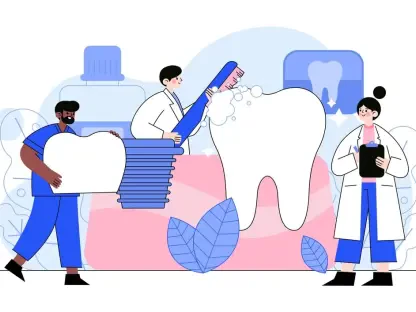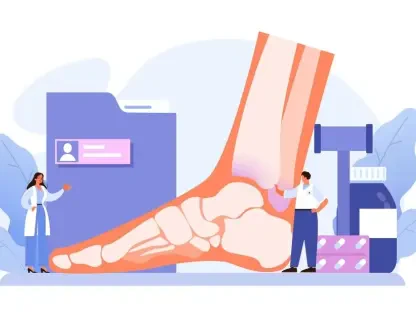In a bustling emergency room in Chicago, a doctor faces a critical decision with incomplete patient data, risking a delayed diagnosis that could cost a life, a scenario that plays out daily across the U.S. where fragmented systems hinder timely care. Yet, a seismic shift is underway as artificial intelligence (AI) steps in to bridge these gaps, driven by bold leadership at the U.S. Department of Health and Human Services (HHS) and the Centers for Medicare & Medicaid Services (CMS). This technological wave promises to redefine healthcare, slashing costs and improving outcomes for millions of Americans.
The significance of this transformation cannot be overstated. With healthcare costs spiraling and data silos obstructing critical information, HHS and CMS leaders are leveraging AI to tackle systemic inefficiencies head-on. Their vision, backed by the Trump administration, merges government infrastructure with private-sector innovation, aiming to create a responsive, affordable system. This story explores how AI is reshaping diagnostics, patient empowerment, and data sharing, while spotlighting the personal motivations and strategic partnerships fueling this revolution.
Why AI Is Redefining Healthcare Today
The current state of U.S. healthcare reveals a pressing need for change, with costs consuming nearly 18% of GDP and millions facing delays in care due to disjointed records. AI emerges as a powerful tool to address these challenges, offering solutions that range from predictive analytics to streamlined administrative tasks. Under HHS guidance, this technology is not just a futuristic concept but a present-day game-changer, poised to save lives by accelerating critical insights.
HHS and CMS are championing AI as a means to cut through bureaucratic red tape, ensuring that patients and providers benefit from faster, more accurate interventions. Leaders within these agencies recognize that the stakes are high—every missed diagnosis or delayed treatment represents a failure of the system. By prioritizing AI adoption, they aim to create a landscape where technology supports human expertise, not replaces it, setting a new standard for care delivery.
The Critical Need for Tech-Driven Reform
Skyrocketing expenses and fragmented data systems have long plagued healthcare, often leaving patients navigating a maze of disconnected providers. HHS Deputy Secretary Jim O’Neill and CMS Acting Administrator Amy Gleason have highlighted these flaws, drawing from personal struggles like Gleason’s experience with her daughter’s rare condition, which was nearly derailed by siloed medical records. Their urgency reflects a broader call for efficiency in a system that too often fails those it serves.
With strong backing from the Trump administration, the push for technology as a cornerstone of reform is gaining momentum. The focus is on creating a cost-effective ecosystem where AI and data-sharing tools eliminate unnecessary delays. This drive toward modernization is seen as essential, not optional, to meet the growing demands of an aging population and increasingly complex health challenges.
AI’s Transformative Power in Healthcare Under HHS
AI is revolutionizing multiple dimensions of healthcare through targeted initiatives led by HHS and CMS. Enhanced diagnostics stand out, with AI tools boosting accuracy and supporting doctors in high-stakes decisions, while programs ensure payers cover these innovations to prevent financial strain on providers. Additionally, patient empowerment is taking shape through AI assistants and chatbots, helping individuals manage chronic conditions with greater autonomy.
Beyond clinical applications, AI is accelerating drug discovery, as noted by O’Neill, cutting down timelines for new treatments in the pharmaceutical sector. Data interoperability, a long-standing barrier, is also being addressed via CMS efforts like a national provider directory and FHIR-based APIs, aiming for seamless information sharing by 2027. These efforts, supported by the Health Technology Ecosystem Initiative involving 60 private companies, underscore a comprehensive approach to reducing inefficiencies across the board.
Leadership Insights and Tangible Outcomes
HHS Deputy Secretary Jim O’Neill advocates for rapid AI integration, stating, “Faster is better,” emphasizing that swift deployment, even with minimal regulation, can yield affordability and better care if quality remains paramount. His perspective prioritizes immediate benefits over potential risks, reflecting a pragmatic approach to innovation. This stance drives internal adoption as well, with a large language model now used by thousands of HHS’s 60,000 employees weekly to streamline tasks like summarizing complex reports.
CMS Acting Administrator Amy Gleason adds a personal dimension, recounting her daughter’s delayed diagnosis due to scattered records across six health systems. She envisions AI companions guiding patients daily within a few years, transforming how individuals interact with healthcare. Her dual role as a leader and a parent fuels a commitment to practical, patient-centered solutions that promise real-world impact.
Building a Tech-Forward Future Through Collaboration
HHS and CMS are crafting a clear path for AI integration, balancing oversight with private-sector dynamism to ensure sustainable progress. Stakeholders can engage by leveraging CMS resources like the upcoming national provider directory and updated digital identity systems on Medicare.gov, which aim to consolidate reliable data for broader use. These tools are designed to simplify access and foster trust in shared information.
Private innovation is equally vital, with CMS’s forthcoming app store set to offer vetted AI chatbots and disease management solutions under the Interoperability Pledge. Supporting data-sharing frameworks to dismantle silos aligns with HHS’s target of seamless access by 2027, while awareness of workforce shifts—such as hiring tech talent from giants like Apple and Google—signals new opportunities for collaboration. These steps, rooted in partnerships with 60 companies through the Health Technology Ecosystem Initiative, provide a roadmap for active participation in reshaping healthcare.
Reflecting on a Tech-Driven Legacy
Looking back, the journey of AI in U.S. healthcare under HHS and CMS leadership marked a pivotal era of transformation. Their commitment to merging government infrastructure with private innovation laid a foundation for improved diagnostics, empowered patients, and unified data systems. Leaders like Jim O’Neill and Amy Gleason drove this change with a blend of urgency and personal conviction, ensuring technology served human needs.
As this chapter closed, the path forward became clear: stakeholders needed to embrace interoperable tools and advocate for continued investment in AI solutions. The next steps involved scaling these initiatives, refining regulatory balance, and ensuring equitable access to emerging technologies. This legacy of progress pointed toward a future where healthcare could be as responsive and interconnected as the digital age demanded.









